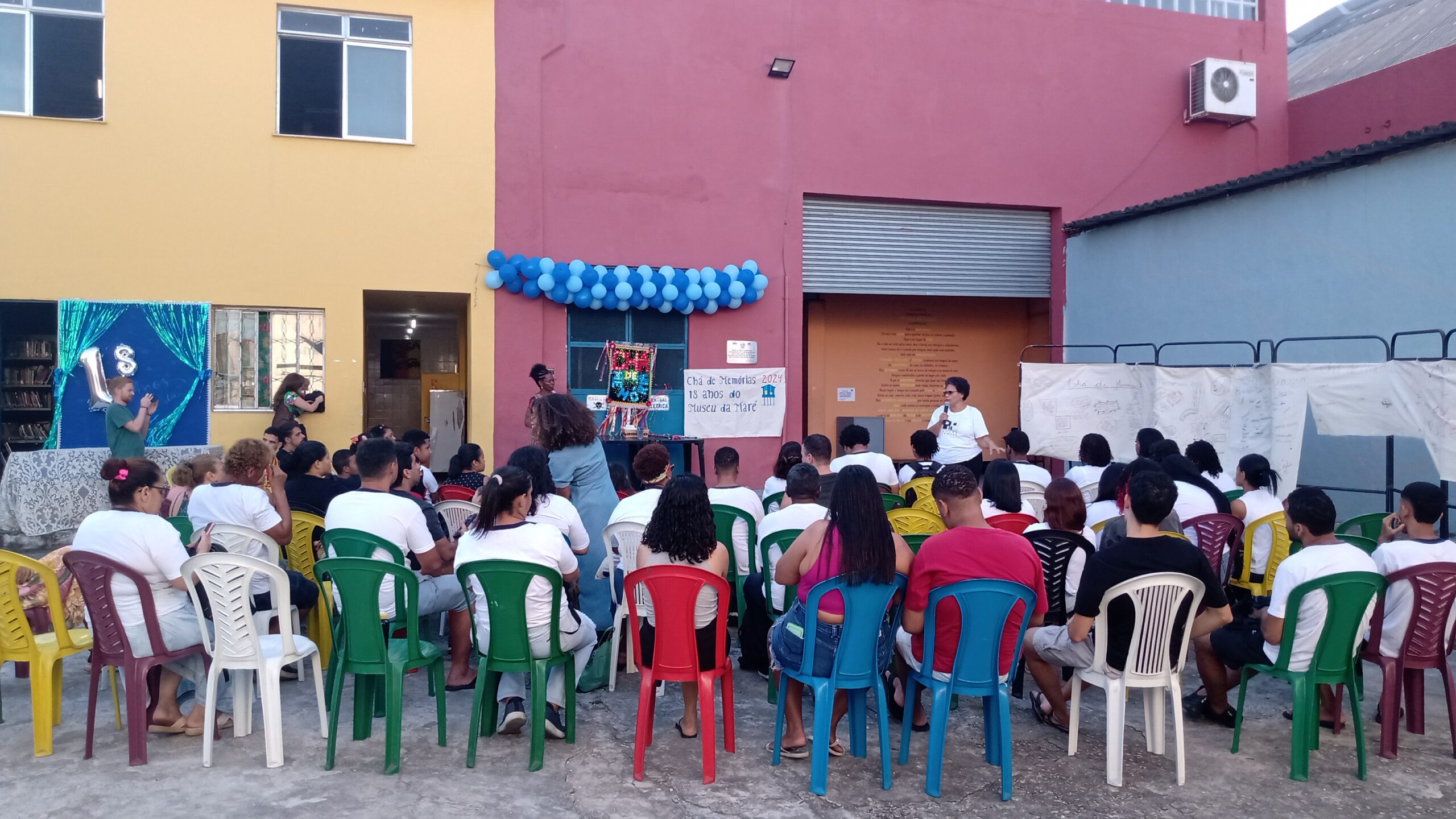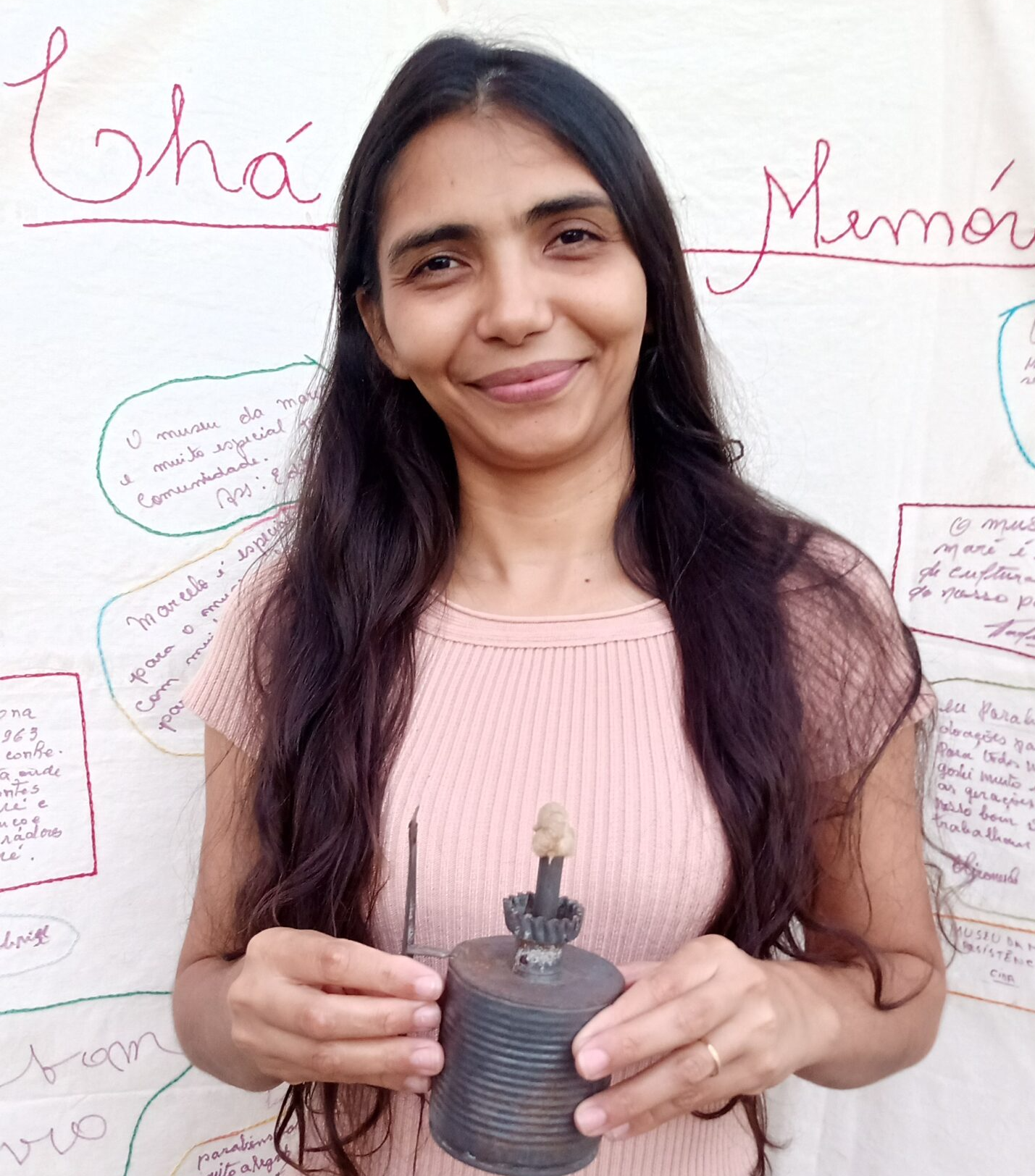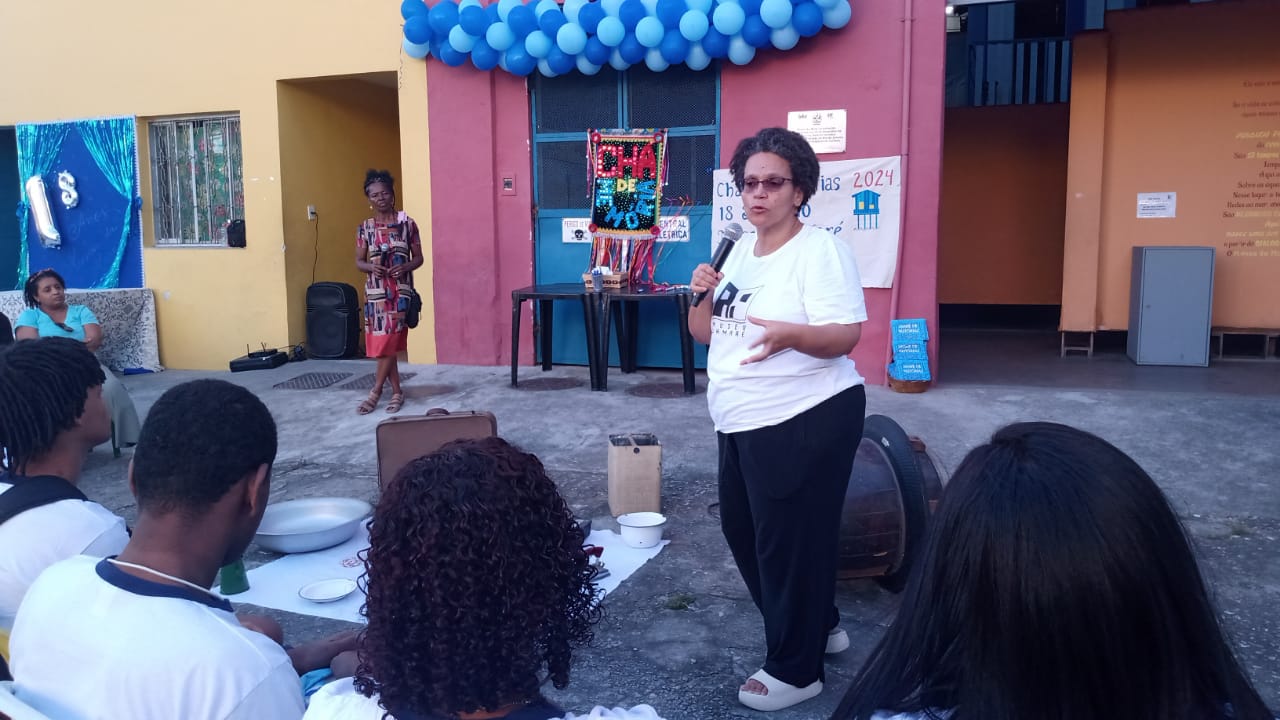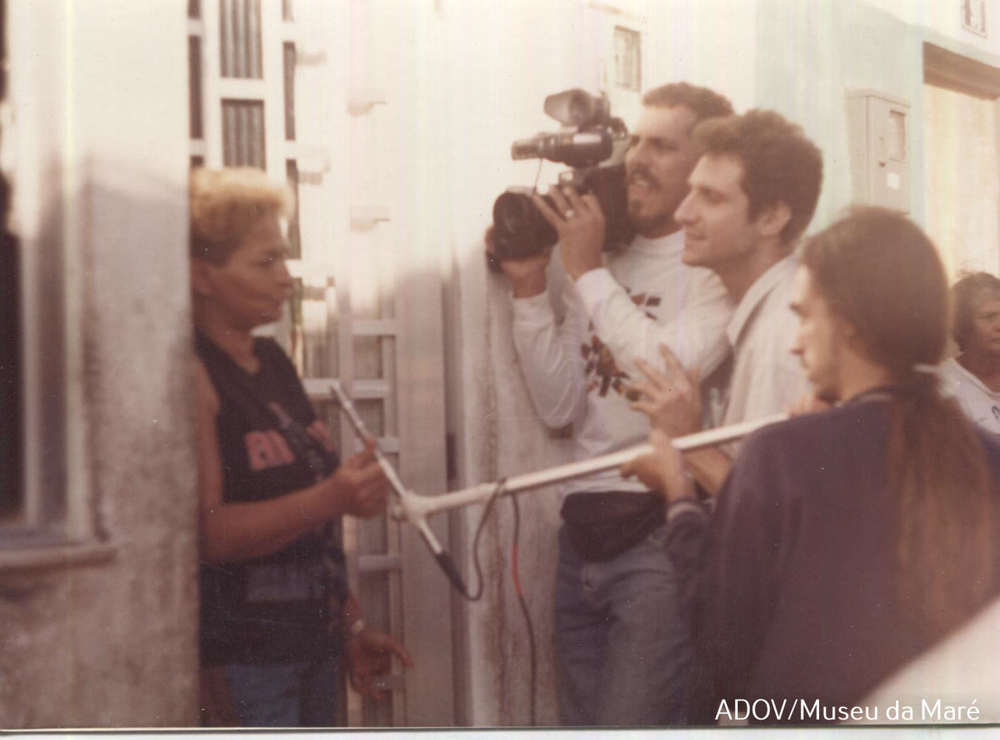
Clique aqui para Português
Held on May 22, the “Tea of Memories” event celebrated the 18th anniversary of the Maré Museum, situated in Complexo da Maré, a group of 16 favelas in the North Zone of Rio de Janeiro, highlighting its significance for local history. Taking place at the museum’s headquarters in the Timbau community, the event’s main purpose was to reclaim Maré’s history through objects donated by residents and the sharing of emotional memories attached to these and other artifacts. The Maré Museum is one of Rio de Janeiro’s two dozen favela museums, many of which are territorial museums produced through social museology: it is the largest installation-based museum and often open to visitors.
The Maré Museum’s 2024 anniversary celebration encouraged 40 participants to reflect on “Maré in 12 Eras,” the name of the museum’s permanent exhibition. The twelve eras are thematic categories that organize and guide visitors through the exhibition, showcasing the diversity of topics surrounding Maré’s history. Residents, students, teachers, and museum representatives wrote about the eras of water, home, migration, resistance, work, celebration, market, faith, daily life, children, fear, and future.
A Portuguese teacher at the Center for Youth and Adult Education (CEJA) in Maré, Helaine Alves, spoke about the era of home and her childhood memories.
“The object I love most in the museum is the stilt house. Because I like houses and I think I could be an architect. I love houses and miniatures. And when I enter the stilt house, I recognize many objects that were part of my childhood. For example, there was the basin… and I remember how thin it was, and that my mother used to wash dishes in that basin. I lived in a very small house; it only had one room. My bathroom was outside, so I remember that basin. For me, it’s a very strong, very deep memory. And this plate too; there are many objects that I recognize when I’m there in the stilt house. It’s the era [in the museum] I love the most. I love the Maré Museum, I love the whole style of the stilt house. Home is the era [of the exhibition] that I love the most.” — Helaine Alves

The Especiais da Maré Association, a collective of parents and caregivers exchanging experiences and information to improve the quality of life of people with disabilities in Maré, spoke about the era of future in a text read by Cláudia Rose, a teacher and founder of the Center for Studies and Solidarity Actions of Maré (CEASM) and of the Maré Museum: “We from Especiais da Maré are very happy for the efforts at inclusion made by the Maré Museum. In the future era, we hope to be everywhere with accessibility, respect, and inclusion for all.”
João Pinto Oliveira, father of the autistic student George Armede from CEJA Maré, wrote to his son about the era of fear. The text was read by teacher Helaine Alves:
“The era of fear, just the name alone is frightening, as it’s a period people are still living in due to police operations. Conflicts between police and criminals, or among themselves, for territorial dominance. The people ask for peace. No more stray bullets. No more mothers suffering, crying for their sons, daughters, or relatives because of shootings. Peace for all.”
At first, the event was scheduled for May 9, but it had to be postponed because of a police raid in Maré. Despite the era of fear, the event could not be canceled; it was only delayed for a few days.
Ver essa foto no Instagram
Among the memories related to objects, Angélica Pinheiro, a homemaker, highlighted the kerosene lamp and its connection to the memories she has with her grandmother, who migrated from the Brazilian Northeast and worked as a seamstress.
“It reminds me of my grandma, in Rio Grande do Norte. There was no electricity there. So, she bought a five-liter can of kerosene to last her a month. And that was the lighting she had in her house… So, she sat at the table to work and kept sewing clothes, and this here reminds me a lot of back then. Looking at all the objects here reminds me of my childhood. The chamber pot… this suitcase here where she kept her and my grandfather’s clothes, it was a suitcase just like this one. This here is very much my childhood at home. We lived in the city. This means a lot, you know. She’d take cotton and burn it until a certain time because she couldn’t burn the kerosene all night long or it would run out.”

Established on April 26, 2002, before the Maré Museum itself, the Dona Orosina Vieira Archive (ADOV) houses a diverse collection including books, academic papers, newspapers, magazines, films, DVDs, VHS tapes, cassette tapes, mini DVDs, photographs, negatives, slides, flyers, brochures, posters, banners, maps, blueprints, and documents. Marli Damascena, who oversees the Archive, notes that these gatherings have been held since 2008:
“In the beginning, we held the Tea with the oldest residents, and over the years, it became quite diverse. We started inviting students from CEJA Maré and the Family Health Clinic. We’ve had university students, and then, over the years, the youth. Because they also have their stories, their memories. So, the Tea of Memories is very important in this sense: for people to come, see, participate, chat, remember the objects, recall the stories… This gathering of people, each one belonging to that place, those objects. The objects we have here in the exhibition, they’re not just objects from here, but also from those who… lived here, especially [those who came] from the Northeast. There are many objects, kerosene lamp, water filter… when people see them, they’re filled with that emotion [transmitted] by the object.”
During the event, Cláudia Rose shared a bit about the museum’s history.
“The museum was founded in 2006, but we started thinking about a museum in 2001… [We kept thinking]: ‘Will it work? Won’t it work? But it’s inside a favela. How’s that going to work?’ And to see that we’ve celebrated 18 years with so many people participating, collaborating, and [that it] still moves people. For me, it’s an achievement. For the people who are here and for Maré in general, I think that having the memory, the history of these residents preserved, disseminated, and valued is of great importance because it’s not just a story from here, a single person’s story. Local history, the history of one person is obviously extremely important, but to think that all these stories can be shared with people from various places.
Through a physical museum, through social media, through the museum’s website, and our online collection. It’s knowing that these stories won’t be forgotten. They are part of a larger story, which is the history of Brazil, and [as such] they must be valued as part of Brazil’s heritage. It’s not just about thinking of Maré within itself, but thinking of Maré as part of this city, and that the residents here contribute to building the history of Brazil.” — Cláudia Rose, teacher and founder of CEASM

The Maré TV Collective and the Birth of a Museum
The history of the Maré Museum does not begin at a single moment, but rather unfolds from numerous actions carried out over time, weaving a rich mosaic of memories and experiences lived by the community.

Between 1989 and 1992, an important milestone was established with the emergence of Maré TV. Made up of residents engaged in valuing local history and identity, Maré TV’s main objective was to produce materials that depicted the community’s reality.
In 1997, CEASM was established as a dedicated space to address community issues. At that time, the Maré TV Collective donated its collection to the Center for Studies, which played a pioneering role in crafting a narrative about Maré from within the community itself.
Among CEASM’s early projects, one already focused on memory: the Maré Memory Network, also made up of residents. This initiative aimed to explore the memory and history of Maré, enhancing the collection through research projects. The Memory Network facilitated training for researching public archives and encouraged residents to donate materials that depicted Maré’s history. Additionally, part of the current collection stems from research conducted at the time at institutions such as the National Archive, the National Library, Casa de Oswaldo Cruz, and the City’s General Archive.
In 1998, a partnership between CEASM and the Oswaldo Cruz Foundation (Fiocruz) promoted a project to train monitors who would work at the Fiocruz Museum of Life, opened in 1999. This partnership was one of the factors that motivated CEASM to consider creating the Maré Museum, which was founded years later, in 2006, in Morro do Timbau. The museum occupies the former site of the maritime transport factory Cia. Libra de Navegação and was initially loaned to CEASM for a ten-year period, though its occupation has since become permanent.
The organization’s central focus is the permanent exhibition that tells the history of Complexo da Maré. It also coordinates other related activities, such as organizing documentary collections, oral history research, the Dona Orosina Vieira Archive, the Elias José Library, and events of various genres. Additionally, it holds over 4,000 museological objects under its care. In its gradually expanded digital collection, there are maps, videos, photographs, newspaper clippings, and other textual documents, as well as some museum items (such as household objects, work tools, religious artifacts, and toys).
Memory is of paramount importance for human existence, both for learning and for the recognition and belonging of individuals to the time and space in which they live. It is through memory that knowledge, wisdom, culture, and narratives about something or someone are retained. Memory is responsible for constructing an identity within the social sphere. It is in this context that events like the Tea of Memories play a crucial role in the appreciation and celebration of memory. Through the sharing of stories and memories among different generations, community bonds are strengthened.
Watch the short video report by Amanda Baroni Lopes at the Maré Museum’s 18th anniversary “Tea of Memories” event:
About the author: Amanda Baroni Lopes is a journalism student at Unicarioca and was part of the first Journalism Laboratory of Maré community newspaper Maré de Notícias. She is the author of the Anti-Harassment Guide on Breaking, a handbook that explains what is and isn’t harassment to the Hip Hop audience and provides guidance on what to do in these situations. Lopes is from Morro do Timbau and currently lives in Vila do João, both favelas within the larger Maré favela complex.
